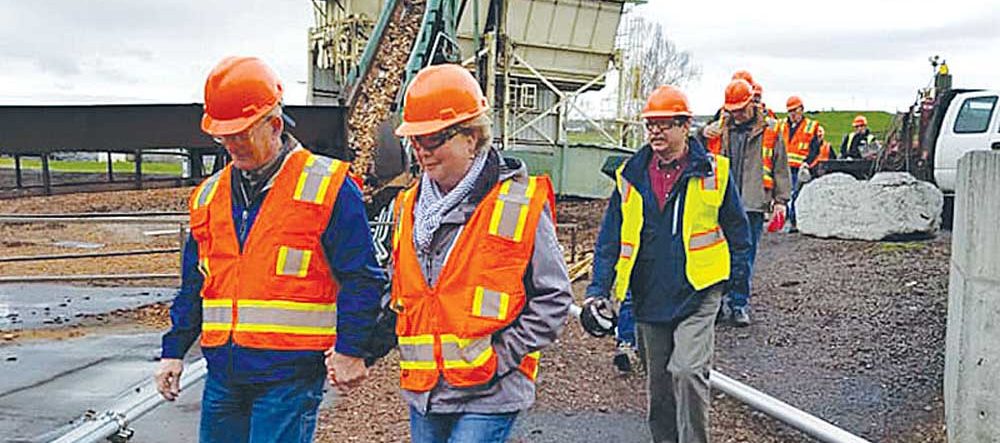Warm Springs water woes aren’t over
Published 11:00 am Tuesday, August 27, 2019

- Flint Scott, a Warm Springs tribal member, moves a rack of 5-gallon containers of water while working at the distribution center on the reservation Thursday.
WARM SPRINGS — Danny Martinez stood on a concrete slab just off a remote road on the Warm Springs Indian Reservation last week and described an unusual sight he witnessed earlier this summer: water gushing out from under the concrete, greening up an otherwise yellow hillside.
The source of the water was a failing pressure release valve under Martinez’s feet. Water was escaping at a rate of at least 100 gallons a minute. Cattails had grown near the slab, creating an environment that appeared well-suited to frogs. Without consistent pressure, the water system was failing further down the pipeline, too.
“It was blowing out pipes and hot water heaters all over the community, including my office,” said Martinez, emergency manager for the Confederated Tribes of Warm Springs. “Blew ’em out because there was 165 psi coming through pipes that can only handle 85 psi. It’s a self-regulating pipe system that was not regulating the water pressure.”
Broken pipes and failing valves at Warm Springs have resulted in several boil water notices over the past 12 months in the impoverished community of around 3,000 people.
The longest boil water notice lasted 81 days, from the end of May to mid-August. While the water system is operational now, the summerlong failure left residents exhausted and frustrated and facing millions of dollars worth of repairs to make the water system last to the next generation.
Water came sporadically through taps during the summer, allowing for periodic toilet flushing or filling up pots with water that could be purified by boiling. But few took their chances drinking the water or bathing in it.
Residents instead visited a water distribution center set up outside a disused school, where authorities had put portable showers and sinks normally used by crews fighting wildfires.
More than 380,000 gallons of water arrived at the site from multiple sources, including St. Charles Health System and a tribe in Alaska, said Martinez, a Warm Springs resident. Water bottles and 5-gallon jugs were stacked in classrooms and hallways.
“The most challenging thing was lifting the water,” said Dorothea Thurby, a volunteer emergency manager who helped distribute water. “I went home each day pretty sore.”
Thurby, who normally works as a teacher at the Warm Springs Early Childhood Education Center, was unable to do her job after the boil water notice forced the child care center to shut down. The Warm Springs resident endured periods when no water flowed through the tap.
“It was hard knowing that our water wasn’t good to drink. I boiled water to do the dishes and used bottled water for drinking and cooking,” she said.
The volunteers also handed out soap, shaving kits, towels and other supplies for the showers. Toys were issued to help children apprehensive about bathing in the small showers.
“The community understood the issue, but it was hard to watch folks as they grew tired and frustrated over time,” Martinez said. “Some of our volunteers suffered, too. They couldn’t shower. They couldn’t drink the water. You really had to meet the community needs while dealing with it yourself.”
Dustin Seyler, a financial counselor and small-business program manager for the Warm Springs Community Action Team , called the 10-week ordeal “life altering.”
“It was a little stressful but you had to adapt,” said Seyler, a father of three children ages 3, 6 and 9. “That’s life, but it’s something I don’t want to go through again and I’m glad that it’s done.”
Seyler said he was concerned about bacteria and wore footwear while using the portable showers. He sprayed alcohol rub on his hands when dealing with the water at home to prevent the spread of bacteria.
“In a community like ours, which is poverty-stricken and you have so many other challenges, it just adds another layer of complexity,” Seyler said.
Authorities initially expected the boil notice to last a week. The notice was extended after a first attempt to repair a broken pipe in the bed of the Shitike Creek resulted in a failure in a different section of the system, according to Alyssa Macy, chief operations officer at Warm Springs.
“The day we turned the system on, we had two immediate failures. The pressure was still too high and we had a major break on the campus area,” recalled Macy. “Our feeling of being super excited was cut short quickly.”
Warm Springs reached out to the U.S. Department of Housing and Urban Development for assistance and was given a letter to proceed. Five pressure-reducing stations were repaired, and the boil notice was lifted after testing showed the water was free of E. coli.
“After the boil water notice was lifted some friends went to the store and got ice in their drink from the soda fountain,” said Macy. “That was something small that you could not have during the boil water notice. People were really excited about having ice in their soda.”
Warm Springs is now addressing other issues related to the pressure-releasing valves and has requested funding from the Bureau of Indian Affairs, which originally installed and maintained the system.
HUD, the Environmental Protection Agency and Business Oregon are collaborating on funding possibilities for Warm Springs, and working groups are expected to provide an update on their findings in September, Macy said.
“At the end of the day, it’s for our children. I don’t want to leave anyone with what I inherited because what I inherited has been a nightmare,” Macy said. “What I want to leave is a system that can support growth, and that is not going to ever put us in a situation where we were over the summer.”
In July, the Oregon Legislature approved $7.8 million in funding to the Confederated Tribes of Warm Springs for three water projects on the reservation, according to Macy. The funds will be used to update the wastewater plant, conduct a water meter project and make repairs on the water distribution network.
While the funding will help fix existing projects, Macy believes tens of millions of additional dollars will be needed to modernize the entire water delivery system.
“That is not just fixing what we have; it is replacing everything if we had unlimited resources to modernize the system,” she said. “We talk about water having a cultural connection as Native Americans. So we need to make those investments and we need to conserve water and be respectful of the resource.”
Seyler, the business counselor, compared the situation at Warm Springs to the plight of Flint, Michigan, in 2014 and said Warm Springs needs to address the issue before Congress.
“The problem is so big, and the scope is daunting — it’s more than the tribe can handle alone,” Seyler said.









